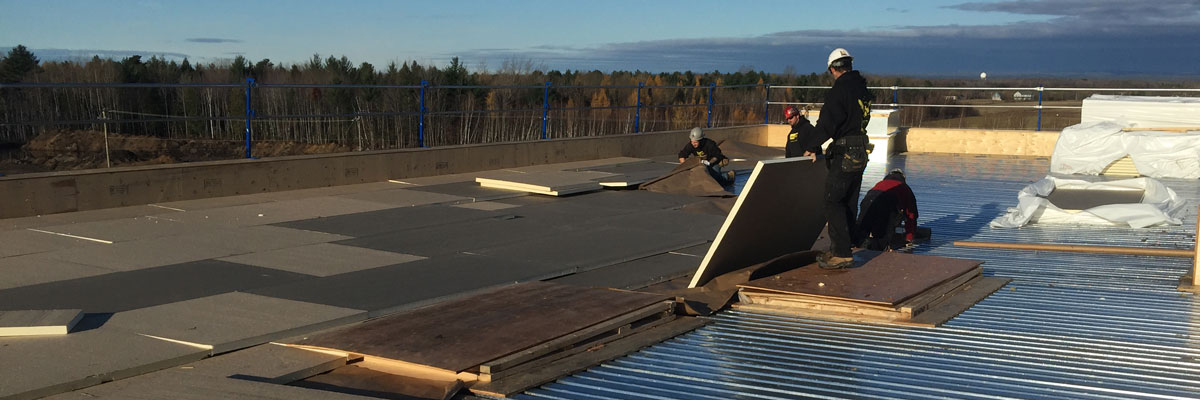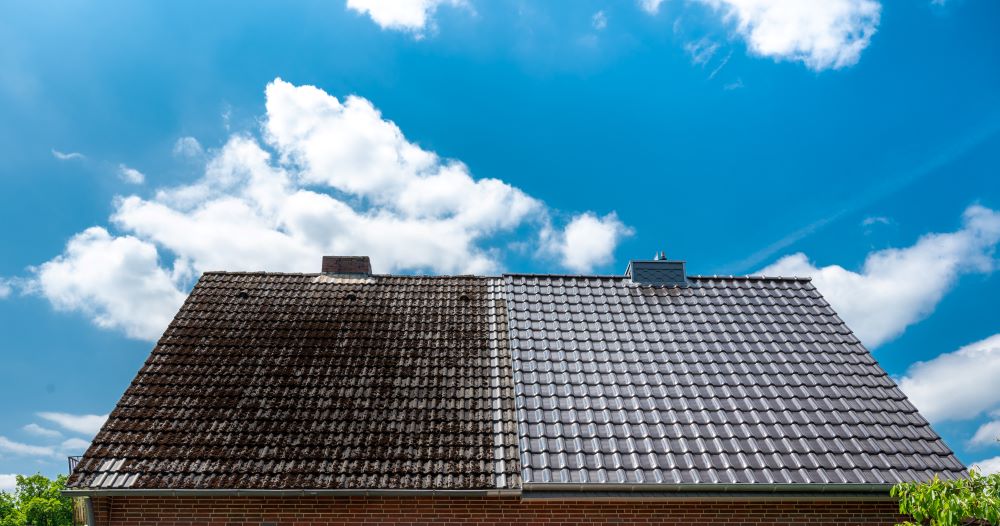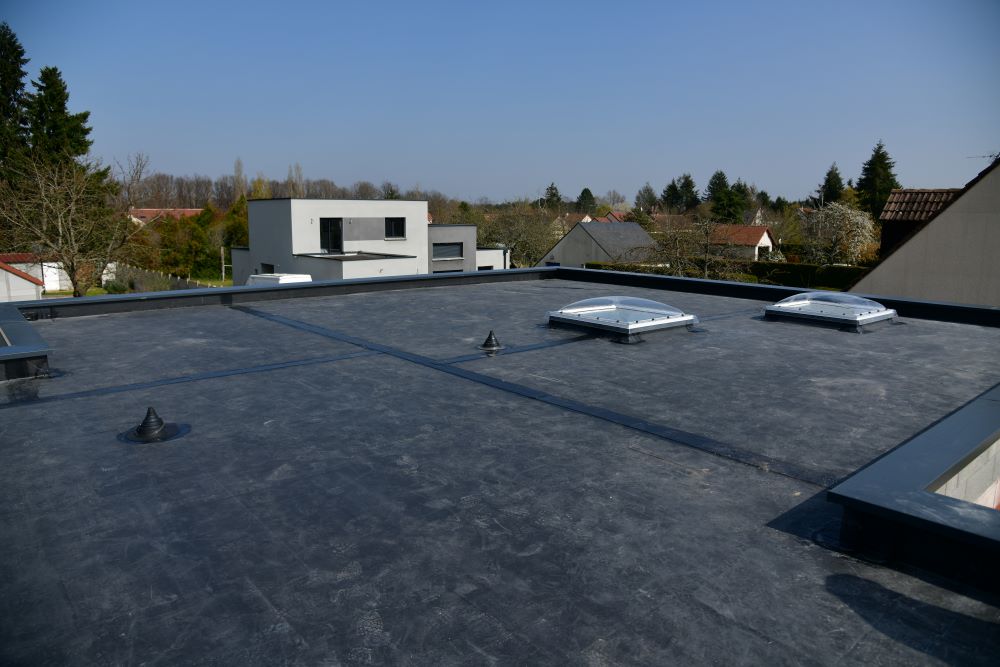Flat roofs are a common feature of modern commercial buildings, as they are both practical and visually attractive. Over time, roofing technology has evolved from traditional asphalt and gravel methods to more advanced and durable solutions. Elastomeric membrane stands out among these innovations as a leading choice for protecting flat roofs.
Our Montreal roofers present you this complete guide to elastomeric membrane roofing.
Elastomeric membrane flat roof covering
Elastomeric membrane is your best option for low-slope or flat roofs. It’s made from polymer modified bitumen (PMB), which gives it flexibility and strength, and is often reinforced with a fiberglass or polyester mat to make it even more durable.
This modern roofing technology was developed through ongoing efforts by the construction industry to develop materials that are both strong and resistant to the elements. It offers a superior alternative to traditional roofing materials.
Elastomeric membrane layers
Elastomeric roofing is composed of two layers. These are heat-welded together during installation to form a single, continuous membrane. Once fused, the membrane acts as a highly effective waterproof barrier that allows the roof to breathe without any risk of moisture build-up.
Base coat
The first or base layer is made of elastomer modified bitumen (EMB). This layer serves as the first barrier against water and weather. It is usually reinforced with a fiberglass or polyester mat to increase its strength and durability. The base coat is applied directly to the roof substrate to create a strong, long-lasting bond.
Finishing coat
The second layer, or finishing coat, is also made of modified bitumen. However, this topcoat is covered with colored granules or another special protective coating. The second layer not only protects the flat roof membrane against UV damage and climatic variations, but also gives the roof its final sleek appearance. Granules can vary in color, making it possible to personalize the roof’s appearance to some degree.
Advantages of elastomeric membrane
Elastomeric roofing offers many significant advantages! Our certified roofers outline the most notable benefits.
Outstanding durability
Elastomeric membrane is widely recognized for being exceptionally durable and long-lasting, with a life expectancy of up to 35 years. This high performance results from its unique composition, which gives it superior resistance to the challenges posed by Quebec’s extreme weather conditions.
Easy to install
In addition to being robust, elastomeric membrane is easy to install and requires very little maintenance. These are major advantages in terms of both initial costs and long-term upkeep. Thanks to hot-application techniques and self-adhesive products, elastomeric membrane can be laid quickly and safely, using minimal labor with a low level of risk.
Multiple customization options
Elastomeric membranes give a sleek, modern appearance to buildings. They are available in a variety of colors, making it possible to customize a roof to match the architectural style of the building. This roofing material is a versatile solution that can be tailored to the specific needs of each project.
How to install an elastomeric membrane
Installing an elastomeric membrane on a roof is a technical process. For safe, effective installation, it’s important to prepare carefully and rely on the expertise of qualified professionals.
1. Preparing the roof
Before installation, the roof must be cleaned of any debris, dust or materials that could prevent the membrane from sticking correctly. Any surface irregularities must be smoothed out so the membrane can be applied evenly.
2. Applying the undercoat
The first layer, or undercoat, ensures that the roof always remains watertight. This layer can be mechanically fastened to the roof, or glued, depending on the manufacturer’s specifications and the condition of the roof.
3. Installing the elastomeric membrane
Next, it’s time to install the elastomeric membrane. For traditional installations, roofers use a blowtorch to heat the membrane so that it fuses with the underlay. It’s important to avoid creating any air bubbles or creases that could compromise the seal.
4. Cold application technique
Cold application is becoming increasingly popular as an alternative to using a blowtorch. This method involves using self-adhesive membranes which do not need to be heated, so pose no risk of fire. This technique is a safe and easy installation option.
5. Finishing
Once the elastomeric membrane has been installed, finishing touches can be applied to the edges of the roof, and around drains and other roof elements, to ensure maximum protection against water infiltration.
6. Inspection and cleaning
Installation ends with a detailed inspection of the membrane to check for defects and make sure all areas of the roof are covered properly. Roofers will also do a final site clean-up.
Elastomeric membrane maintenance
Mantaining an elastomeric membrane is relatively simple and less demanding than for other types of roofing. Still, there are a few things you can do to make your roofing last longer and perform better.
- Regular inspections: We recommend inspecting the roof at least twice a year, usually in spring and autumn, to detect any problems like cracks, bubbles and tears in the membrane, or issues at joints and edges.
- Cleaning: Clean the surface of the elastomeric membrane carefully, using soft brooms or low-pressure washers to avoid causing damage. It is important to remove debris, leaves and other items that may accumulate on the roof and clog drainage systems.
- Minor repairs: If you detect minor damage, such as cuts or punctures, we recommend that you contact a roofing professional as soon as possible.
- Maintenance of drainage systems: Gutters and drains should be checked and cleaned regularly to ensure proper water drainage. Water accumulation on the roof can lead to long-term damage.
- Monitoring after major weather events: Inspect your roof for damage following heavy storms or significant snowfall.
Flat roof maintenance by Duro-Toit
Elastomeric membranes offer durability, exceptional weather resistance and minimal maintenance, making them an ideal solution for flat roofs. However, to guarantee that your roof covering works properly and lasts as long as it should, it’s a good idea to trust professional roofers with installation and maintenance.
Duro-Toit professional roofers have extensive experience in flat roof maintenance, repair and more. We have mastered elastomeric membrane installation and maintenance techniques.
Trust our roofers to provide a high-performance, long-lasting roof. Contact us today to discover how we can help you get the most out of your roof covering.



